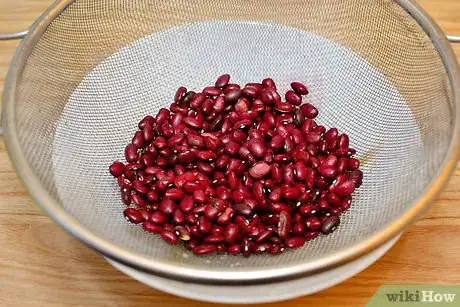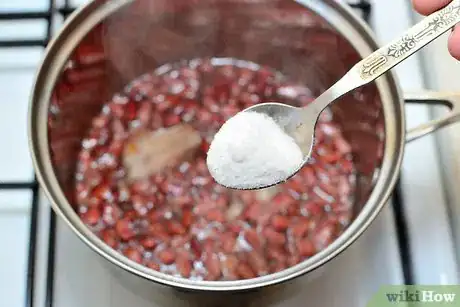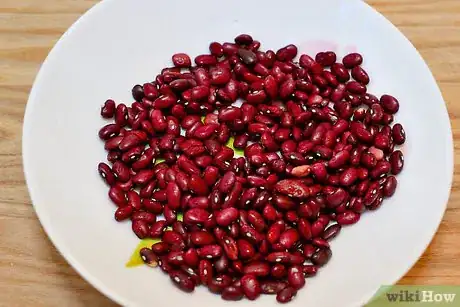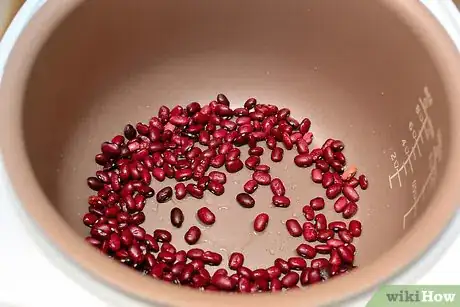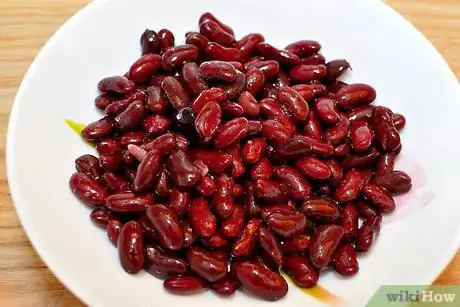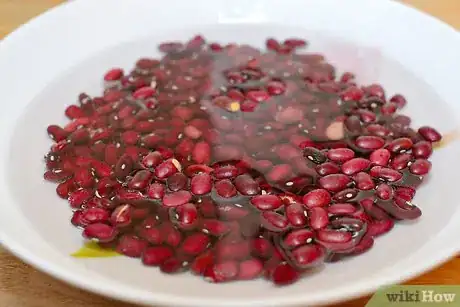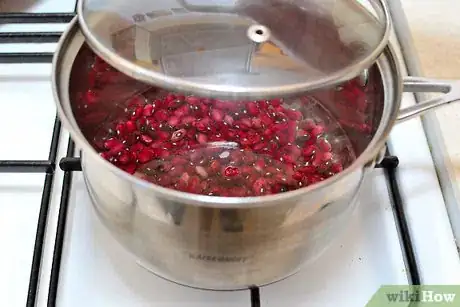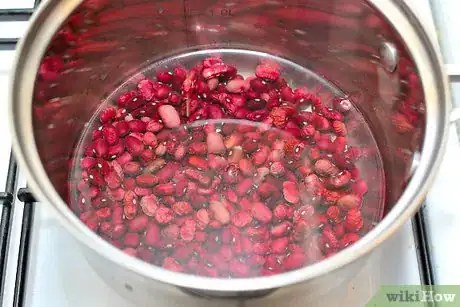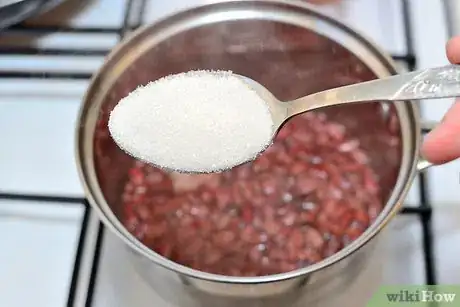wikiHow is a “wiki,” similar to Wikipedia, which means that many of our articles are co-written by multiple authors. To create this article, volunteer authors worked to edit and improve it over time.
There are 10 references cited in this article, which can be found at the bottom of the page.
This article has been viewed 161,440 times.
Learn more...
Adzuki beans are commonly used in the cuisines of Japan, China, and Korea, but you can use them for both Asian recipes and as substitutes for other beans in your favorite American dishes. They're high in protein and lower in calories than many other beans, including black beans, kidney beans, pinto beans, white beans, and garbanzo beans.[1] Keep reading to learn more about how to cook these beans yourself.
Ingredients
Makes 8 to 10 servings
- 4 cups (1 L) dried adzuki beans
- 4 slices bacon (optional)
- 1 tsp (5 ml) salt (optional)
- 1 tsp (5 ml) ground black pepper (optional)
- 1 tsp (5 ml) garlic powder (optional)
- 1 tsp (5 ml) chili powder (optional)
- Water
Makes 4 to 5 servings
- 2 cups (500 ml) dried adzuki beans
- Water
Makes 1.3 lb (600 g) anko
- 7 oz (200 g) dried adzuki beans
- Water
- 7 oz (200 g) granulated white sugar
- Pinch of salt
Steps
Basic Stovetop Cooking
-
1Soak the beans. Place the beans in a large stockpot and fill the pot with water. Allow the beans to soak in the water at room temperature for 1 to 2 hours.[2]
- With most dried beans, it is recommended that you soak the beans before cooking them. Doing so softens the beans and also removes most of the water-soluble components responsible for digestive upset.
- Note that with adzuki beans, however, you can often skip the soaking process without suffering adverse reactions. Soaking will make the beans slightly easier to digest, but it is not absolutely essential.[3]
- You can soak the beans anywhere from 1 hour to overnight.
-
2Replace the water. Drain the water by pouring the contents of the pot through a colander. Rinse the adzuki beans several times under running water before returning them to the pot and adding fresh water.
- The water will need to cover the beans by about 2 inches (5 cm).
- Fill the stockpot with cold water so that the beans cook more evenly.
Advertisement -
3Add the bacon, if desired. If you want to add bacon to the beans, you can do so at this point. Cut the bacon into 1 inch (2.5 cm) pieces and place it directly into the pot of water and beans.[4]
- Bacon gives the adzuki beans a smoky, salty flavor. As such, this works well if you intend to eat the beans on their own or want to add them to a hearty dish, like chili. It may not work so well if you intend to use them in a sweeter or milder dish.
-
4Bring the pot of beans to a boil. Cover the stockpot and bring the water up to a boil over high heat.
-
5Let simmer until tender. As soon as the water reaches a boil, reduce the heat to medium and let the beans continue to simmer until they become tender enough to pierce with a fork.[5]
- If you soaked the adzuki beans beforehand, this should only take about 60 minutes. If you did not soak the beans or soaked them for less than an hour, you might need to wait closer to 90 minutes.
- Tilt the lid slightly as the beans simmer so that steam can escape, thereby avoiding a build-up of pressure.
- Periodically skim off excess foam that rises to the top of the water as the beans cook.
- If necessary, add more water if too much of it seems to escape during the cooking process.
-
6Add desired seasonings. The beans can be served or added to recipes as they are, but if you want something a little more flavorful, you can add salt, black pepper, garlic powder, chili powder, or your other favorite bean seasonings after turning off the heat and draining the beans.
- You should drain the beans before adding your seasonings to ensure that the seasonings stick to the beans and do not get lost or diluted in the water.
-
7Serve. Drain the beans, if you have not done so in the seasoning step, and serve the beans while still hot.
- You can serve adzuki beans in tortilla shells, in a bowl with a side of cornbread, or with cooked rice.[6] The beans can also be added to casseroles, bakes, chili, and stew.
- Alternatively, you can cool the beans and add them to fresh salads.
- You can store cooked adzuki beans in airtight containers for five days in the refrigerator or six months in the freezer.
Pressure Cooking
-
1Soak the beans. Place the adzuki beans in a medium to large saucepan or bowl and fill the container with enough water to cover the beans. Let the beans soak overnight at room temperature.
- Strictly speaking, it is not essential to soak adzuki beans. You can cook them in a pressure cooker without pre-soaking them, but pre-soaking will reduce the cooking time and can also help strip away any water-soluble components responsible for digestive upset.[7]
- If you want the beans to keep their color, shape, and aroma, do not soak them before cooking them.
-
2Drain the water. Pour the beans and water through a colander to drain them. Rinse the beans under running water several times.
- Rinsing the beans after draining them will remove more of the water-soluble fibers still clinging to the outer skin of the beans.
-
3Place the beans in a pressure cooker. Transfer the drained beans to a pressure cooker and add 2 cups (500 ml) of cool water. Cover the pressure cooker and set it to cook on high pressure.
-
4Cook until tender. If you soaked the beans, this should only take 5 to 9 minutes. If you did not soak the beans, this can take 15 to 20 minutes.[8]
- Drain any excess water when done by pouring the contents of the pressure cooker through a colander again. Note that there should not be much water left after the beans finish cooking, though.
- When ready, the beans should be tender enough to pierce with a fork.
-
5Serve. Serve the adzuki beans alone while still hot or add them to your favorite bean dish recipe.
- If serving the beans warm, you can serve them with tortilla shells, cornbread, or rice. You can also add them to casseroles, bakes, chili, and stew.
- If you decide to let them cool, you can enjoy the beans mixed into a green mixed salad.
- If you have leftovers, you can store the cooked adzuki beans in an airtight container for five days in the refrigerator or six months in the freezer.
Adzuki Bean Paste (Anko)
-
1Soak the beans. Place the adzuki beans in a medium saucepan or glass bowl and fill the dish with water. Let the beans soak at room temperature overnight.
- In many applications, it is not essential to soak adzuki beans. For bean paste, however, you should soak the beans to soften them and to remove water-soluble elements that can cause digestive upset.
-
2Rinse and replace the water. Drain the beans by pouring the contents of the saucepan through a colander. Rinse several times under running water and add them back to the saucepan along with fresh, cool water.
- Rinsing the beans after soaking them will help clean off any dirt or water-soluble fibers still clinging to the outer skins.
- Make sure that there is at least 1 to 2 inches (2.5 to 5 cm) of water above the beans when you return them to the saucepan.
- Keep in mind that the beans will roughly double in size by the end of the cooking process, so make sure that the saucepan is big enough to contain them.
-
3Boil the water. Transfer the saucepan to the stove and turn the heat on high. Let the beans come to a boil, uncovered.[9]
- Turn off the heat after the water begins to boil. Cover the saucepan and let the beans sit for 5 minutes on the stove with the heat off.
-
4Drain and replace the water again. Pour the contents of the saucepan through your colander again to drain off this initial bit of cooking liquid.
- There is no need to rinse the beans this time.
-
5Bring to a boil. Return the adzuki beans to the saucepan and pour just enough water into the pan to cover the beans. Turn the heat on high and let it reach a boil.
-
6Simmer until very tender. After the water reaches a boil, turn the heat down to medium-low and let the beans continue to cook at a simmer. You will need to do this for 60 to 90 minutes.[10]
- Keep the beans uncovered as they cook.
- Periodically use a slotted spoon to push the beans floating on the top underneath the surface of the water.
- Add water as needed throughout the cooking process. The water will evaporate, and as a result, the water level will decrease as the beans continue to cook. You need to have enough water to cover the beans.
- On the other hand, adding too much water can cause the beans to move around too violently and break apart.
- To test the beans for doneness, pick up one bean and squeeze it with your fingers. You should be able to mash it with your fingers very easily.
-
7Add sugar and mix. Add the sugar in three separate batches, stirring after each addition. Turn the heat up to high and cook until the beans reach a paste-like consistency.[11]
- Stir the beans constantly after adding the sugar.
- Let the beans continue cooking on high heat even after they reach a boil.
- Turn off the heat with the paste reaches the right consistency, but do not remove the saucepan from the stove yet.
-
8Add salt. After the sweet adzuki bean paste cools slightly, sprinkle the salt in and give the mixture a final mixing with a wooden or plastic mixing spoon.
- The paste should still be warm, but not so warm that it is burning-hot to the touch.
- The consistency should thicken further and become more solid as the bean paste cools.
-
9Transfer to a separate container and finish cooling. Pour or spoon the bean paste into a separate container. Cover loosely and let it cool to room temperature on the counter.[12]
- Do not leave the anko (bean paste) in the pot as it finishes cooling.
-
10Use or store as needed. You can use your finished sweet adzuki bean paste in your favorite Asian desserts and snacks, including mochi, anpan, daifuku, dango, dorayaki, manju, taiyaki, mooncakes, and chalboribbang.
- Any bean paste that is not used immediately should be kept in an airtight container and placed in a refrigerator for up to a week or a freezer for up to a month.[13]
Community Q&A
Did you know you can get answers researched by wikiHow Staff?
Unlock staff-researched answers by supporting wikiHow
-
QuestionWhat are adzuki beans used for?
 wikiHow Staff EditorThis answer was written by one of our trained team of researchers who validated it for accuracy and comprehensiveness.
wikiHow Staff EditorThis answer was written by one of our trained team of researchers who validated it for accuracy and comprehensiveness.
Staff Answer wikiHow Staff EditorStaff Answer
wikiHow Staff EditorStaff Answer
Things You'll Need
- Saucepan or stockpot, with lid
- Colander
- Separate glass dish
- Slotted spoon
- Wooden or plastic mixing spoon
- Fork
- Serving dishes
- Airtight plastic bags or containers
References
- ↑ http://www.oprah.com/food/Superfoods-List-2012-Sunchokes-Adzuki-Beans-Chia-Seed/6
- ↑ https://food52.com/recipes/10476-simple-seasoned-adzuki-beans
- ↑ https://www.organicauthority.com/eco-chic-table/beans-dont-need-to-soak-before-cooking
- ↑ http://www.healthygreenkitchen.com/seasoned-aduki-beans.html
- ↑ https://www.bobsredmill.com/recipes/how-to-make/basic-preparation-instructions-for-adzuki-beans/
- ↑ https://food52.com/recipes/10619-perfumed-adzuki-beans-and-rice-with-bourbon-and-bacon
- ↑ https://www.thekitchn.com/why-i-soak-dried-beans-for-24-150811
- ↑ http://www.bbcgoodfood.com/glossary/aduki-bean
- ↑ https://www.allrecipes.com/recipe/238507/anko-sweet-red-bean-paste/

